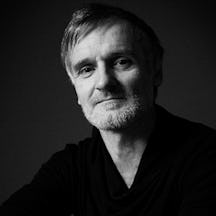A disastrous night out left Laura Grace Simpkins in no doubt: she was drinking too much and needed help, but her doctor was more concerned about her mental health than her alcohol consumption. Several appointments and many months later, Laura was diagnosed bipolar and prescribed lithium. Here she recounts the beginning of a troubled new relationship with a mysterious drug.
Diagnosed bipolar, prescribed lithium
Words and narration by Laura Grace Simpkinscomposition and sound design by Alice Boydphotography by Matjaž Krivicaverage reading time 6 minutes
- Serial

One of the few memories I have of my 21st birthday is suddenly being on stage at a nightclub, clinging to a pole. A friend had pushed me up there, apparently, after convincing a decidedly unimpressed drag-queen stripper to incorporate me into her provocative routine.
“It’s her birthday!” had been my friend’s desperate plea.
But I was beyond six-inch hot-pink velvet-heeled commiseration by that point. As the drag queen gyrated sexily around me, I whimpered and I wailed until mascara ran down both my cheeks. My best friend had left earlier on in the evening, after I’d drunk-screamed at him in the fancy stairwell of a decadent cocktail bar.
Drinking too much was an unfortunate pattern of mine. I’d either drink to the point of passing out or, if I was lucid enough, I would find the nearest balcony and try to fling myself over it. Let’s just say I was a lot to handle, and most people had had enough.
That night I stayed with my friend, whose sofa I lay on, motionless, for 24 hours. The day after that, as I was leaving his flat, I swore I would never drink again. I knew I needed help. So I went to the doctor’s.
“I’m less concerned about the drinking, if I’m honest,” the doctor said, after she’d nodded along to my kaleidoscopic tale, “and more about some of the other things you’ve mentioned. I’m going to refer you to see a psychiatrist…”
Six months later, I found myself sitting opposite a psychiatrist at an internationally renowned research clinic at the NHS Warneford Hospital in Oxford. After a chat, a phone call to my parents, and several weeks of me intending to plot red and blue lines on an online mood chart, she pronounced me bipolar, handing me a piece of letter-headed paper with the diagnosis printed on it. It was like a very cheap marriage certificate.
“Keep hold of that,” the psychiatrist told me. “It’s important to have a record of all our letters.”
I’ll get it framed, I thought. Mum and Dad would love it hung up in the downstairs loo.
The psychiatrist wanted to prescribe lithium. “It’s the gold standard,” she said. “It’s by no means perfect, but the evidence suggests it’s the best we’ve got.” “Gold standard” sounded impressive, but I couldn’t do as she’d instructed – at least not straight away. I’d always been terrified of needles, and with lithium I’d have to have weekly blood tests as I gradually adjusted to or ‘titrated’ onto it, which would decrease to one every three to six months ad infinitum after that.
The blood tests were non-negotiable. “Lithium has a remarkably narrow therapeutic window,” the psychiatrist reassured me. “Too little, there’s no point being on it; too much, dare I say, is toxic.”
A few months later I gave the go-ahead. On no evidence at all I believed that, instead of the crook of my arm, I’d be able to tolerate blood being taken out of the back of my hand. “It will be more painful!” I was admonished by shocked nurse after shocked nurse. I didn’t like it, but I coped. I’ve been on lithium ever since, for over four years.
An elemental encounter
It was the summer of 2017 when I started taking lithium.
Most of that summer, spent in a student-less Oxford after blagging my final exams, was magical. In my desperately nostalgic memory, I spent it as glamorously and as gracefully as a Fitzgeraldian flapper girl, wearing cat’s-eye sunglasses and a big, floppy hat; reading books about yogic philosophy on blossom-strewn lawns; swimming in the cool canals while tourists punted past.
In actuality, I had been warned by the psychiatrist to be particularly vigilant about nipping any potential adverse effects in the bud. I experienced most of the common ones that summer – dizziness, drowsiness, increased thirst and urination, nausea – thankfully only mildly.
Most noticeable was my newly acquired hand tremor. Initially I was spellbound by the involuntary vibration of my fingers and stared at them with a devoted studiousness. The novelty soon wore off. The shaking gradually intensified and became magnified by everyday tasks like holding a pen or typing on my phone.
I quivered the whole night long, kept awake by an inconsiderate full-body tremor. Something seismic was taking place.
Suddenly, it was my final night in Oxford. Before I went to bed, I gulped down the prescribed dose of two 400 mg lithium tablets with a glug of water, then laid my head down on a marshmallowy pillow. I closed my eyes, eager to sleep. Instead, I quivered the whole night long, kept awake by an inconsiderate full-body tremor. Something seismic was taking place.
To save up for my next degree, I moved back home and got a job in an art gallery. Working in an office made my difficulty recalling certain words and phrases more obvious. I regularly forgot terms crucial to the business, like ‘materiality’, ‘evocation’, and ‘biopolitics’. I became paranoid about the skills I had always prided myself on – my sharp memory and dry wit. I began to doubt my love of art.
As the year at home progressed, it was evident to me, as it was to my parents, that my moods had stabilised somewhat. Privately, I thought I had lost some of my former spark, my pizzazz. That was an opinion I kept to myself. How much of me is me? I wondered. And how much of me is lithium?
I read linguist Mel Y Chen’s ‘Animacies’. I was struck by Chen’s account of becoming ‘mercurial’ as a result of mercury poisoning; how they cautiously attribute their periodic introversion to childhood allergy injections or fillings in their teeth. I reckoned I’d had an encounter similar to that of Chen’s: just with another element. One that was changing who I was from the inside out.
‘Honeymoon’, a sound art collaboration.
‘Lithium’ is derived from the Greek word lithos, meaning ‘stone’. Where mercury had made Chen mercurial, lithium had ‘lithified’ me. ‘To lithify’, geologically speaking, is a verb used to describe sediment that has compacted under pressure, expelled fluids, and, I read out loud: “Eventually turned to rock.”
About the contributors
Laura Grace Simpkins
Laura Grace Simpkins writes and performs about herself, madness and death. Her writing has been published by the Guardian, New Scientist and the British Medical Journal’s Medical Humanities, as well as broadcast on BBC Radio. She is currently working on her first book.
Alice Boyd
Alice Boyd is a London and Bristol-based composer and sound artist. Her work uses the voice, everyday sounds and electronic textures to tell stories about the world around us. She has been selected as one of Sound and Music’s New Voices composers 2020, and has worked with venues such as Eden Project and Donmar Warehouse.
Matjaž Krivic
Matjaž Krivic is a documentary photographer capturing stories of people and places, primarily focusing on environmental issues. For over 25 years he has covered the face of the earth in his intense, personal and aesthetically moving style that has won him several prestigious awards. The past six years he has been immersed in the visual documentation of the lithium industry and also how companies and even countries are essentially washing away the climate sins of the past to create a greener and sustainable future.


